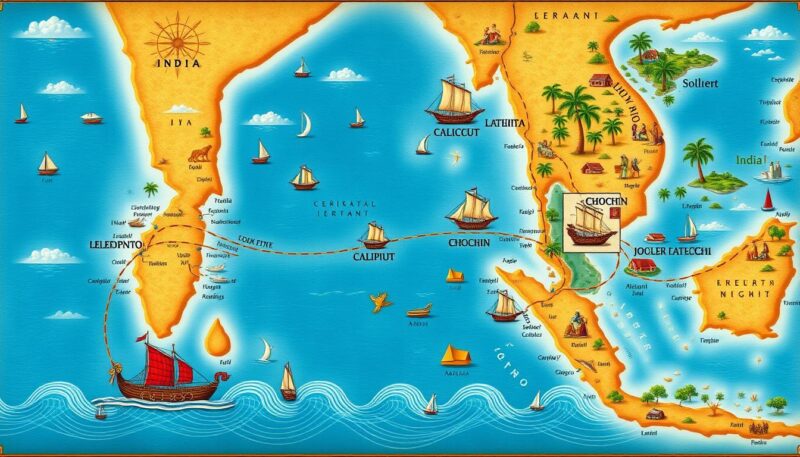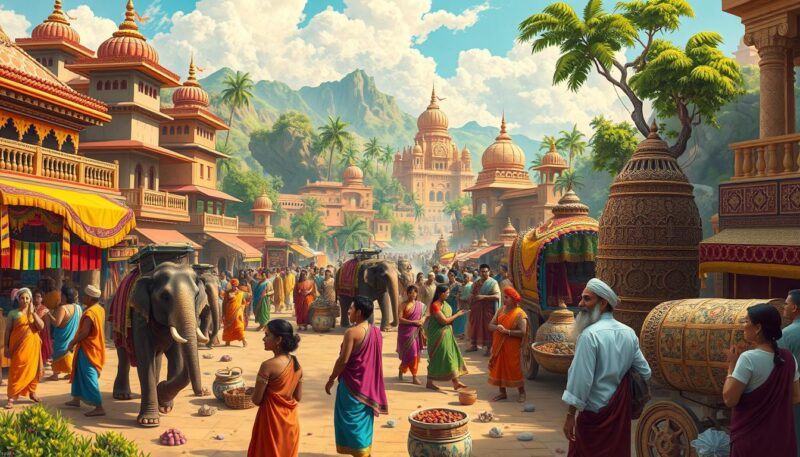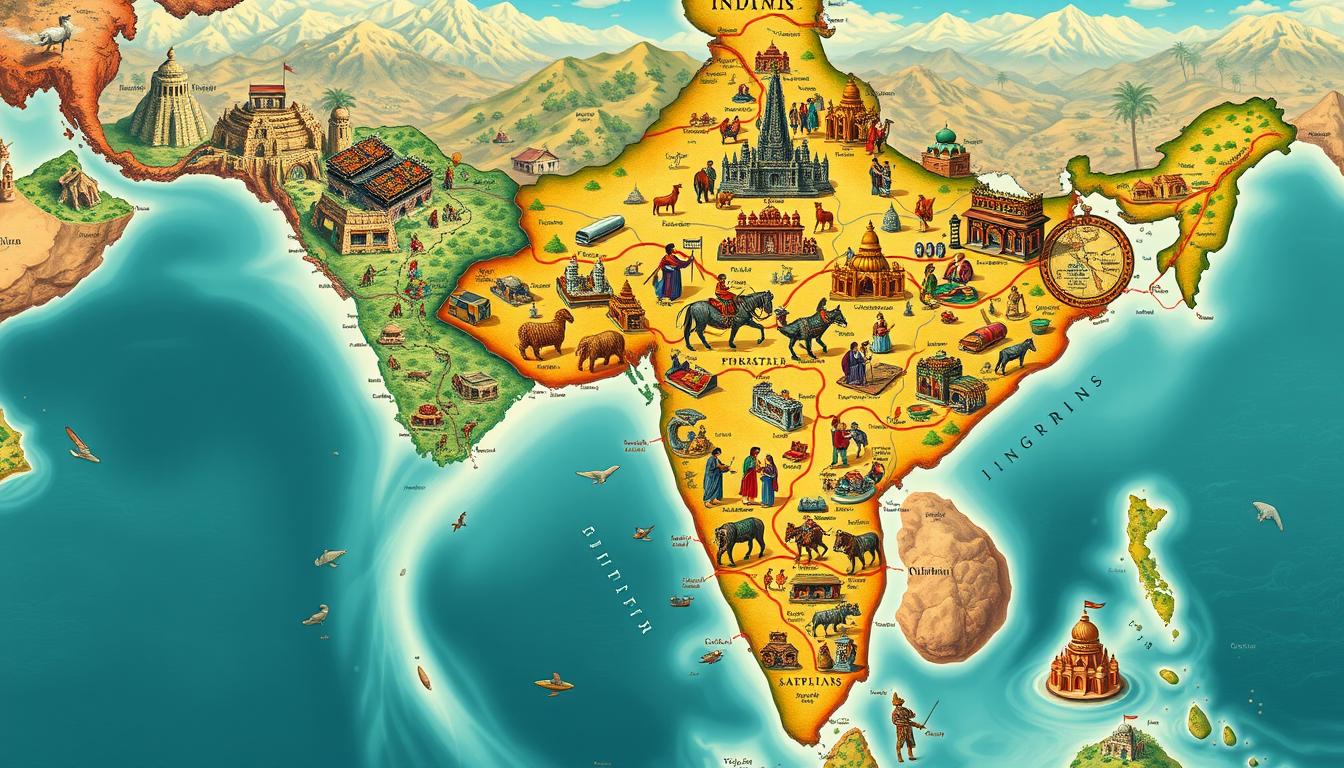India’s rich history encompasses not only vibrant cultures and diverse traditions but also significant ancient commerce that influenced global development. The historical trade in India is marked by extensive ancient Indian trade routes that connected various parts of the world, facilitating the exchange of goods, ideas, and cultures. Among the most prominent of these routes were the Silk Road and the vast network of maritime trade links, both of which played crucial roles in shaping the economy and culture of ancient India.
By the beginning of the first century A.D., merchants, diplomats, and travelers could theoretically cross the ancient world from Britain and Spain in the west to China and Japan in the east. The Silk Road, dating back to the Han Dynasty, connected the Far East and Europe, with India serving as a pivotal intermediary in the exchange of commodities. This trade network carried an array of goods such as silk, spices, paper, and gunpowder, all of which left lasting impacts on the societies they touched.
The Royal Road, established by the Persian ruler Darius I, spanned over 1,600 miles and played a vital role in facilitating trade and communication across the Achaemenid Empire. This intricate network also integrated Indian traders into a broader commercial community, fostering an exchange of not only goods but also knowledge and culture. Indian botanical-medical knowledge systems enriched European botanical-medical documents, demonstrating the profound impact of these interactions.
Key Takeaways
- The Silk Road connected the Far East and Europe, with India as a crucial intermediary.
- India was involved in the exchange of valuable commodities like silk, spices, paper, and gunpowder.
- The Royal Road, built during the Achaemenid Empire, facilitated extensive trade and communication.
- Indian traders engaged in both land and maritime trade routes.
- Ancient commerce in India significantly influenced European botanical-medical knowledge.
Your exploration of the historical trade in India starts with understanding these fascinating ancient Indian trade routes. Their immense influence on global commerce and cultural exchanges laid the foundation for India’s economic prosperity and the rich tapestry of its history.
Silk Road Influence on India
The Silk Road was a pivotal trade network that profoundly impacted India, weaving together various cultures, goods, and ideas. Stretching from western Asia to the western coast of India, this ancient route facilitated trade and cultural exchanges through trade for over a thousand years, enriching India’s history and economy. The Peaking engagement of Romans around the Christian era, the introduction of Persian cultural elements, and the spread of Buddhism are just a few testaments to the manifold impacts of this ancient corridor.
Establishment and Importance of the Silk Road
The Silk Road traversed vital regions of the Indian subcontinent, including Kashmir and the Tibetan plateau, becoming a conduit for livelihood, trade, and the exchange of ideas. Goods like spices, precious metals, ivory, gems, and horses were commonly traded along these routes, showcasing the diversity of ancient trade practices. The discovery of monsoon winds revolutionized navigation and significantly enhanced India’s trade connections across the Arabian Sea.
Roman engagement with India around the turn of the Christian era intensified two-way trade missions. Indian pepper, textiles, precious stones, and pearls were traded for Roman gold coins, glass, and metals. This period was marked by a flourish in economic and cultural exchanges through trade, as recorded in Hebrew texts, Babylonian writings, and Greek works like Strabo’s Geography and the Periplus Maris Erythraei.
Trade Goods and Cultural Exchanges
The Silk Road facilitated a rich plethora of cultural exchanges through trade, as Persians, Chinese, Romans, and Greeks interacted with Indian merchants and scholars. Persian ornament patterns were adopted in Indian carpet weaving, painting, and calligraphy, a transformation encouraged by Mughal Emperors from the 15th century. Trade routes through Ladakh linked India with China, turning Ladakh into a significant Buddhist center enriched by these exchanges.
Furthermore, internal trade within regions like Ladakh enabled the exchange of food, clothing, and other essentials, fostering harmonious relationships amongst diverse communities. The Karakoram Pass connected India with Silk Road routes, making it possible for both skilled and unskilled populations to find employment. This connectivity also promoted agricultural cultivation in hilly areas and gave impetus to art and religion.
| Region | Key Trade Goods | Cultural Contributions |
|---|---|---|
| Kashmir & Tibetan Plateau | Spices, Ivory, Gems | Expansion of Buddhism |
| Ladakh | Food Grains, Pashmina Wool | Link Between India and China |
| Karakoram Pass | Cotton, Silk, Precious Stones | Harmonious Community Relations |
The profound cultural influence extends to Persian elements shaping Indian etiquette, language, clothing, and gastronomy. The adoption of Persian cultural patterns left a lasting legacy on the Indian subcontinent, proving that the Silk Road was not merely a trade route but also a significant conduit for cultural exchanges through trade.
Maritime Trade Routes of India
The maritime trade routes of India have been pivotal in shaping the nation’s rich history of commerce and cultural exchange. These sea routes connected India not only with nearby regions but also with distant lands, fostering a robust network of international trade.
Key Ports and Networks
India’s strategic location along the Indian Ocean facilitated its emergence as a key player in maritime trade. Key ports such as Muziris, Bhrigukaccha, and Arikamedu played significant roles in the ancient Indian trade routes, serving as bustling hubs for the exchange of goods. These ports nurtured an extensive network of trade, stretching across the Arabian Sea and beyond.
During the classical era (4th century BCE–3rd century CE), major empires such as the Mauryan Empire in India and the Roman Empire in the Mediterranean were actively involved in this thriving maritime network. The Indian Ocean trade routes connected India with Southeast Asia, Arabia, and East Africa, beginning at least as early as the third century BCE. In the medieval era, empires like the Umayyad and Abbasid caliphates in the Arabian Peninsula continued to enhance these trade connections.

Trade with Western Asia and the Mediterranean
The ancient Indian trade routes were essential in establishing strong commercial and cultural ties with Western Asia and the Mediterranean. Goods such as spices, textiles, and precious stones flowed from India to regions like the Persian Gulf, the Red Sea, and the eastern Mediterranean. The influence of powerful trading empires, like the Han Dynasty in China and the Roman Empire, emphasized the importance of these routes.
The Chola Empire in southern India exemplified India’s wealth, dazzling travelers with its affluence, while the Srivijaya Empire prospered by taxing vessels in the Malacca Straits. Moreover, the rise of the Tang and Song dynasties in China further encouraged maritime trade, solidifying India’s position in the global trade network.
| Historical Period | Key Empires | Trade Dynamics |
|---|---|---|
| Classical Era (4th century BCE–3rd century CE) | Roman Empire, Mauryan Empire | Extensive sea networks, trade of spices, textiles, and precious stones |
| Medieval Era (400–1450 CE) | Umayyad and Abbasid Caliphates | Flourishing trade in the Indian Ocean basin |
| 1405 Ming Dynasty Expeditions | Ming Dynasty | Expeditions to major trading partners |
| 17th Century | Dutch East India Company, British East India Company | Competition for spice trade dominance |
Ancient Indian Trade Practices and Goods
Trade in India has been believed to exist since 600 BC, indicative of a long-standing tradition of commerce. The ancient trade practices were highly intricate, with the Harappan civilization pioneering initial exchanges centering primarily around gold. Over 2600 years of India’s history, trade goods from ancient India have expanded to include spices, textiles, and metals—a testament to the region’s diverse economic landscape.
Guilds like the shreni were influential in regulating trade, maintaining high standards in the exchange of goods. These guilds ensured that ancient trade practices were systematic and reliable, thus facilitating smoother economic transactions. Financiers and coinage systems further complemented these practices. Coins minted during the sixth century BCE were punch-marked and made of silver and copper. Notably, the Kushanas and Gupta rulers issued large quantities of gold coins, which were crucial in long-distance trade.
India’s ancient economy thrived on its diverse trade routes. The Silk Route connected India to China and the Roman Empire, while other important routes included the Spice Route, Salt Route, Incense Route, Tin Route, and The Amber Road. These pathways facilitated the movement of multifarious trade goods from ancient India, enriching both domestic and international markets.
Ancient Indian cities such as Pataliputra, Ujjain, Puhar, and Mathura emerged as significant trade centers, each specializing in different commodities. For instance, Pataliputra was known for its luxury goods, whereas Ujjain became famous for textiles. The wealth derived from trade significantly enhanced urban living standards and contributed to the growth of towns and cities.
| Period | Main Trade Goods | Key Trade Routes |
|---|---|---|
| Harappan | Gold, Lapis Lazuli, Carnelian | Sutkagendor, Mesopotamian |
| Mauryan | Textiles, Spices, Metals | The Grand Route, Silk Route |
| Kushana | Silk, Gold Coins | Silk Route, Northwest Pathways |
| Gupta | Pure Gold Coins, Spices | Silk Route, Maritime Routes |
| South Indian Dynasties | Kanchipuram Silk, Textiles | Maritime Trade to West Asia |
Luxurious items like semiprecious stones and spices were among some of the highly sought-after trade goods from ancient India. These, along with textiles, significantly contributed to India’s economic prosperity, leading to the growth of urban centers. The trade practices of ancient India were instrumental in creating a flourishing economy that was well-regulated and diverse, positioning India as a critical node in global trade networks.
Impact of Trade on Indian Culture and Economy
The historic trade networks of India, both maritime and overland, significantly impacted the country’s culture and economic landscape. Trade held a central role in shaping India’s economic prosperity and urbanization, transforming the living standards of its populace through flourishing commerce and vibrant exchanges with various cultures.
Economic Prosperity and Urbanization
Trade has been a pivotal force behind the economic prosperity and urbanization of ancient India. With the rise of bustling marketplaces and trade hubs, cities like Pataliputra and Madurai flourished. Guilds, known as shrenis, played a crucial role in streamlining trade activities, ensuring efficiency and fostering connections with political spheres. This interaction spurred civic development, leading to the establishment of advanced urban centers, enhanced infrastructures, and improved living standards.
Examining trade routes, it is clear that international commerce was essential for India’s economy. The discovery of large hoards of Roman coins featuring emperors like Augustus, Tiberius, and Nero, points to extensive trade relations between Rome and India. Goods like pepper, precious stones, and silk were exchanged for Roman commodities, as well as gold coins, amplifying India’s wealth.

Cultural Exchanges Through Trade
Trade facilitated rich cultural exchanges through trade, altering the cultural landscape of ancient India. Social institutions and trade guilds not only boosted commerce but also fostered cultural exchanges. The influence of foreign trade was particularly evident in South India, where numerous Roman items, including pottery and beads, were found through archaeological excavations, highlighting a dynamic exchange of goods and ideas.
In North India, the impact of trade on Indian culture extended to knowledge transfers that influenced literature, art, geography, and religious expressions. Renowned structures like the Ajanta Caves, which were funded by trade profits, are a testament to this cultural fusion. The patronage of art and religion through trade profits, coupled with the propagation of Buddhism, underscored the profound cultural impact of commerce.
Moreover, the Indian Ocean trade routes further connected India to parts of Africa, Asia, and the Middle East, amplifying the exchange of goods, ideas, and technologies. Navigational advancements like the use of lateen sails and the astrolabe were pivotal in facilitating these interactions. As traders established communities along these routes, they introduced new cultural traditions, forming city-states and fostering an environment of cultural amalgamation.
The impact of trade on Indian culture, economic prosperity, and urbanization is undeniable, reinforcing India’s role as a dynamic participant in the ancient global economy and a melting pot of diverse influences.
Conclusion
The intricate tapestry of ancient Indian trade routes reveals an extraordinary narrative that highlights India’s critical role in global commerce and its profound influence on the cultural and economic landscape. Positioned strategically along the ancient trade routes between East and West, India managed to establish intricate connections with Central Asia, Tibet, and China through land-based points like the Silk Road, and forged significant maritime pathways through the Arabian Sea, Bay of Bengal, and Indian Ocean.
Spanning a 5,700-kilometer-long seaboard and leveraging major ports, ancient India facilitated robust exchanges in goods and innovations. Important centers like Champa, Pataliputra, Kausambi, and Taxila played pivotal roles in these exchanges, linking inland regions to the maritime trade routes. The historic sites of Lothal and Dholavira along the coastal belt, particularly the Harappan settlements, signified India’s maritime prowess, enabling trade with civilizations such as Mesopotamia and regions like Dilmun and Magan. Commodities such as copper, gold dust, and lapis lazuli traveled these routes, enriching both the trade and economy in ancient India.
Furthermore, the impact of the Indian Ocean trade from 300 BCE to 700 CE underscores the significance of India’s maritime connections. These routes fostered not only economic prosperity but also cultural interchanges, as evidenced by the trade relations with the Roman Empire. This era brought about a rich blend of goods and cultural exchanges, contributing to a thriving, cosmopolitan society. As you reflect on the legacy of ancient Indian trade routes, you gain insight into how these pathways shaped the ancient world, forging connections that reverberate to this day.
FAQ
What were some significant trade routes in ancient India?
Significant trade routes in ancient India included land-based routes, such as those connected to the Silk Road, and maritime routes that traversed the Indian Ocean. Key ports like Muziris, Bhrigukaccha, and Arikamedu played essential roles in facilitating this trade.
How did the Silk Road influence trade in India?
The Silk Road facilitated extensive trade between western Asia and the western coast of India, bringing diverse goods and cultures into India. This route enabled economic and cultural exchanges that greatly enriched Indian society and its interactions with the world.
What kind of goods were traded on the Silk Road involving India?
Many valuable items were traded, including Indian pepper, precious stones, pearls, textiles, and a range of spices. In exchange, India received Roman gold coins, glass, and metals, which contributed to its wealth and economic development.
Which were the key ports in India’s maritime trade routes?
Key ports such as Muziris, Bhrigukaccha, and Arikamedu were vital points in India’s maritime trade routes, connecting the Persian Gulf and Red Sea regions and ensuring active trade with Egypt and the eastern Mediterranean.
How did India’s maritime routes impact its trade with Western Asia and the Mediterranean?
India’s maritime routes allowed direct sailing across the Arabian Sea due to the discovery of monsoon winds. This enhanced navigation and strengthened trade ties with Western Asia, the Mediterranean, and beyond, fostering a thriving exchange of goods and culture.
What were some of the primary trade goods from ancient India?
Ancient India traded a wide array of goods, including spices, textiles, semiprecious stones, and botanical-medical knowledge systems. These commodities significantly influenced various regions, particularly Europe, and encouraged advancements in fields like medicine and natural history.
How did trade contribute to economic prosperity and urbanization in ancient India?
Trade brought immense wealth to India, leading to economic prosperity and the growth of towns and cities. Profits from trade supported the agrarian economy and fostered urbanization, improving living standards and contributing to civic development through institutions like the shreni guilds.
In what ways did cultural exchanges through trade impact Indian culture?
Cultural exchanges through trade enriched Indian art, literature, geography, and religious expression. Buddhism, for example, received significant patronage from trade interactions. The exchange of knowledge and goods with foreign lands made a lasting impact on India’s cultural and artistic landscape.
Source Links
- https://www.history.com/topics/ancient-middle-east/silk-road
- https://www.metmuseum.org/toah/hd/trade/hd_trade.htm
- https://whc.unesco.org/en/tentativelists/5492/
- https://en.unesco.org/silkroad/content/did-you-know-trade-routes-himalayas
- https://en.unesco.org/silkroad/countries-alongside-silk-road-routes/india
- https://journals.openedition.org/asiecentrale/419
- https://www.thoughtco.com/indian-ocean-trade-routes-195514
- https://heritagesciencejournal.springeropen.com/articles/10.1186/s40494-020-00425-9
- https://unacademy.com/content/upsc/study-material/ncert-notes/towns-and-trade-in-ancient-india/
- https://testbook.com/ugc-net-history/ancient-indian-trade-routes
- http://indianculture.gov.in/node/2730145
- https://www.britannica.com/place/India/Contacts-with-the-West
- https://library.fiveable.me/ap-world/unit-2/exchange-indian-ocean/study-guide/mYUclryioD6e045jpPb3
- https://minpaku.repo.nii.ac.jp/record/3115/files/SES32_016.pdf
- https://bmcr.brynmawr.edu/2019/2019.09.54/
- https://en.wikipedia.org/wiki/Indo-Roman_trade_relations

